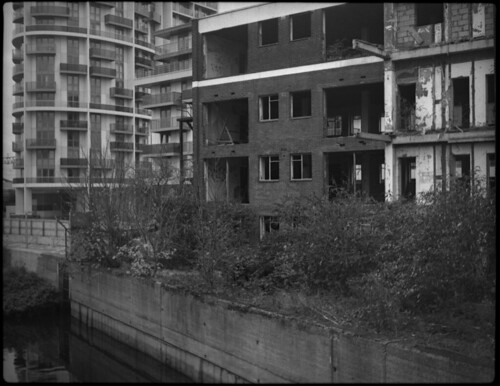 |
| Canalside Properties, Baby Ikonta, Ilford FP4 |
For last Saturday's 127 Day, I retraced my steps from
last year, walking around the perimeter of the London 2012 Olympic Park. On this year's July 127 Day, I had used the last of my 'new' 127 format films, and also shot 35mm film cut and rolled to 127 backing paper. Since then, I'd bought a couple of expired films, one roll of
Macophot UP 100 with a "develop before" date of 1/2004, and a roll of Ilford FP4 from December 1976. I had previously used 127 FP4 with a similar date with
good results two years ago. I also had a roll of 828 Verichrome Pan (with a develop before date of August 1977) which I had removed from its backing paper and backed with 127 paper.
828 was one of Kodak's numerous film formats from the early 20th century, and was made well into the 1980s; the format uses unperforated 35mm film. I'd used old
Verichrome Pan on a few occasions before, with mixed results. All three films were shot with the Baby Ikonta. The FP4 and Verichrome Pan films were
stand developed, while the Macophot UP 100 film was developed according to the
Massive Dev Chart recommendations. Of the three films, the FP4 was clearly the best, despite being the oldest film. Other than some pinholing, the film probably could have been shot at box speed, rather than at 50, which was what I rated all three films at to compensate for age.
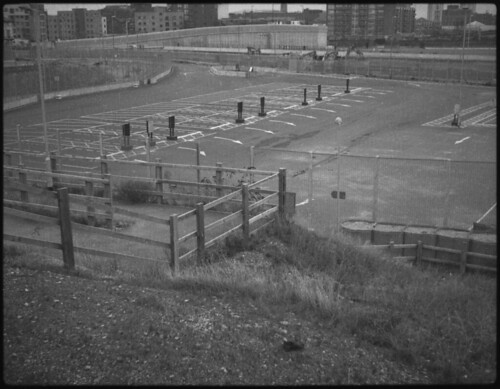 |
| Car Park, Baby Ikonta, Macophot UP 100 |
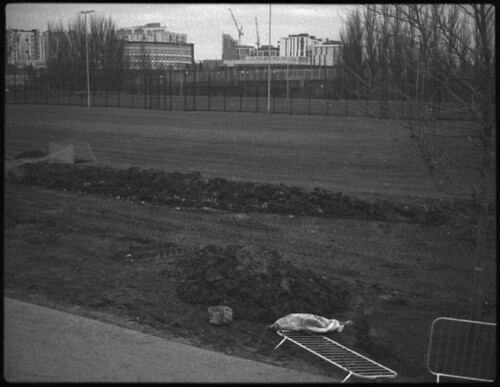 |
| Drapers Field, Baby Ikonta, Macophot UP 100 |
The Macophot UP 100 had noticeably more fog, and a patterning which appears to have come from the backing paper: while hanging up after developing, I could also see the numbering from the backing paper, but this cleared on drying (this has been a manufacturing problem with a number of films in recent years). Additionally, both the Macophot UP 100 and Verichrome Pan films both had a very pronounced curl, while the FP4 was no worse than 120 film would be.
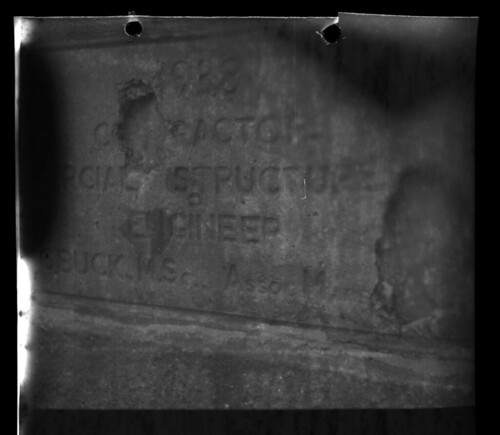 |
| Verichrome Pan |
The Verichrome Pan film had a patterning from the backing paper showing rather more than on the Macophot film and also suffered a little from light leaks. As 828 film is fairly short, this provided 12 images on the film rather than the 16 or 17 frames from conventional 127 film; the image above is from the very end of the roll with holes from the film clip for hanging.
At the end of the day, to finish the Ilford FP4 film, I returned to shoot a couple of the night photographs from
two years ago, although I couldn't exactly match the second image below due to continuing work around London's Olympic site.
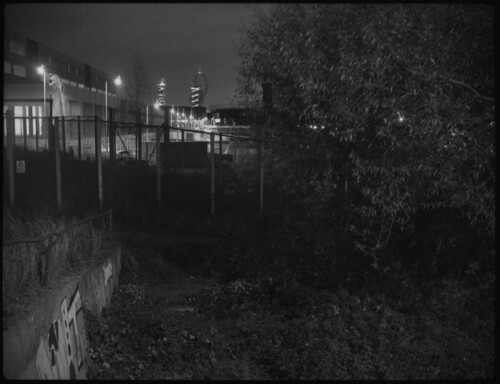 |
| London 2012 Olympic Park, Baby Ikonta, Ilford FP4 |
 |
| A106 Eastway, Baby Ikonta, Ilford FP4 |






Having a wonderfully named Houghton Butcher Ensign Carbine 'Tropical Model' folding camera that uses 116 size film, I found two rolls of Verichrome Pan film from 1966, and apart from a bit of fog, and a little texture to the images, they produced good images with cool development in HC110. I have since used the Verichrome papers on numerous occasions to re-roll some Agfa and Kodak 70mm C41 with excellent results.
ReplyDeleteThank you for your comment. As I say in the post, I've had some good results with Verichrome Pan, and some not so good. I still haven't gotten around to making a film slitter to cut down 120 to 127 size for use with my 127 cameras, but there's still 127 films out there.
Delete